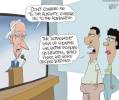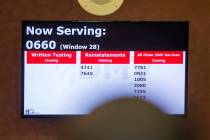Nevada’s kids need to read: Latest vocabulary rankings are pathetic
Nevada’s fourth-graders scored higher than their peers in only six other states on the vocabulary section of the 2011 National Assessment of Educational Progress, released this week by the U.S. Department of Education. Nevada eighth-graders surpassed their peers in only five other states. In other words, Nevada’s average scores were in the bottom 15 percent.
In one example for eighth-graders, a question on the test stated mint syrup permeated the shaved ice. Students were then asked whether this meant the mint syrup:
A. Caused the shaved ice to melt slightly.
B. Formed the shaved ice into clumps.
C. Spread all the way through the shaved ice, or
D. Made the shaved ice taste better.
Nationally, about 51 percent of students gave the correct answer. Nevada kids did not do as well.
Example words in the fourth-grade test included “spread” and “underestimate,” which most students understood. But “barren” and “flourish” were words that garnered correct student responses less than half the time.
David Driscoll, chairman of the governing board that oversees the assessment, noted a “consistent relationship” between vocabulary scores and reading comprehension scores.
Average scores of white and Asian students surpassed those of blacks and Hispanics nationwide by 20 to 30 points. And the gap isn’t closing, especially in Nevada.
If racial gaps remain, look for the reason in more single-parent households – often headed by individuals who themselves have low educational attainment – where reading and discussion of challenging material is rarely emphasized.
The problem with a stunted vocabulary, of course, is that the young person, fearful of “looking dumb,” may avoid reading or discussion on more challenging topics, thus avoiding precisely the exposure most likely to solve the problem. A limited vocabulary cuts young people off from becoming well informed voters, as well as opportunities for career advancement.
There’s no need to “re-invent the wheel,” here. The solution is well known. First, the schools must resist the “dumbing down” of texts and other reading material. Books that have not been run through a blender, casting out three-syllable words while stressing inoffensiveness, are likely to do better in holding the student’s interest, even as they build vocabulary.
Simply put: Read great writers in their original words, not in dumbed-down and redacted versions.
But this is a place where parents can also intervene and accomplish a lot. Subscribing to newspapers somewhat more challenging than are likely to be found in the supermarket checkout aisle is not a prohibitive expense, though these can’t do the job through osmosis – they have to be read and discussed in the home.
Book aisles are also better places to teach children to browse than the toy aisles. Old toys are generally thrown away, whereas a book, properly cared for, can last a lifetime – as can the value of a good vocabulary.


















